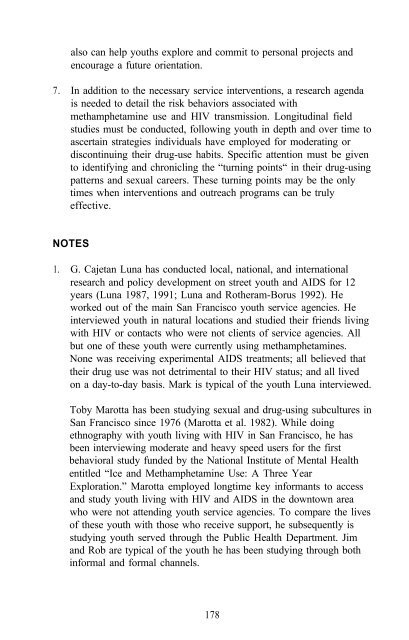The Context of HIV Risk Among Drug Users and Their Sexual Partners
The Context of HIV Risk Among Drug Users and Their Sexual Partners
The Context of HIV Risk Among Drug Users and Their Sexual Partners
Create successful ePaper yourself
Turn your PDF publications into a flip-book with our unique Google optimized e-Paper software.
7.<br />
also can help youths explore <strong>and</strong> commit to personal projects <strong>and</strong><br />
encourage a future orientation.<br />
In addition to the necessary service interventions, a research agenda<br />
is needed to detail the risk behaviors associated with<br />
methamphetamine use <strong>and</strong> <strong>HIV</strong> transmission. Longitudinal field<br />
studies must be conducted, following youth in depth <strong>and</strong> over time to<br />
ascertain strategies individuals have employed for moderating or<br />
discontinuing their drug-use habits. Specific attention must be given<br />
to identifying <strong>and</strong> chronicling the “turning points“ in their drug-using<br />
patterns <strong>and</strong> sexual careers. <strong>The</strong>se turning points may be the only<br />
times when interventions <strong>and</strong> outreach programs can be truly<br />
effective.<br />
NOTES<br />
1. G. Cajetan Luna has conducted local, national, <strong>and</strong> international<br />
research <strong>and</strong> policy development on street youth <strong>and</strong> AIDS for 12<br />
years (Luna 1987, 1991; Luna <strong>and</strong> Rotheram-Borus 1992). He<br />
worked out <strong>of</strong> the main San Francisco youth service agencies. He<br />
interviewed youth in natural locations <strong>and</strong> studied their friends living<br />
with <strong>HIV</strong> or contacts who were not clients <strong>of</strong> service agencies. All<br />
but one <strong>of</strong> these youth were currently using methamphetamines.<br />
None was receiving experimental AIDS treatments; all believed that<br />
their drug use was not detrimental to their <strong>HIV</strong> status; <strong>and</strong> all lived<br />
on a day-to-day basis. Mark is typical <strong>of</strong> the youth Luna interviewed.<br />
Toby Marotta has been studying sexual <strong>and</strong> drug-using subcultures in<br />
San Francisco since 1976 (Marotta et al. 1982). While doing<br />
ethnography with youth living with <strong>HIV</strong> in San Francisco, he has<br />
been interviewing moderate <strong>and</strong> heavy speed users for the first<br />
behavioral study funded by the National Institute <strong>of</strong> Mental Health<br />
entitled “Ice <strong>and</strong> Methamphetamine Use: A Three Year<br />
Exploration.” Marotta employed longtime key informants to access<br />
<strong>and</strong> study youth living with <strong>HIV</strong> <strong>and</strong> AIDS in the downtown area<br />
who were not attending youth service agencies. To compare the lives<br />
<strong>of</strong> these youth with those who receive support, he subsequently is<br />
studying youth served through the Public Health Department. Jim<br />
<strong>and</strong> Rob are typical <strong>of</strong> the youth he has been studying through both<br />
informal <strong>and</strong> formal channels.<br />
178
















